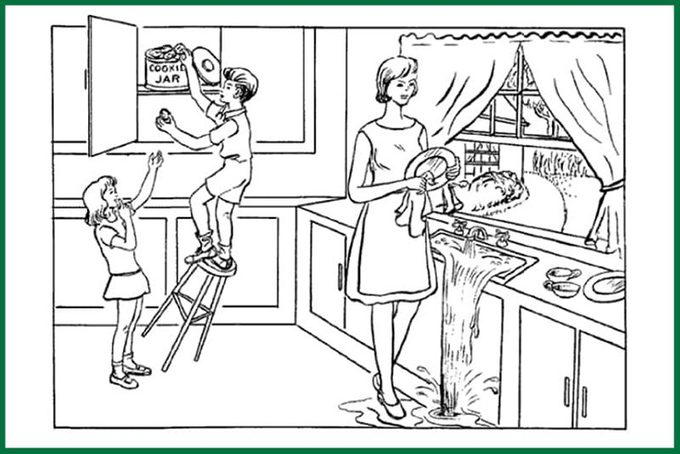Could This Image Predict Your Risk for Alzheimer’s Disease?

A new study uses artificial intelligence to interpret participants' use of language, which could give patients, doctors, and caregivers hints about a future Alzheimer's diagnosis.
If a picture is worth a thousand words, a simple image—which may be able to predict your risk for Alzheimer’s disease—may be worth many more.
About 5 million Americans have Alzheimer’s disease, the memory-robbing condition that can occur in middle-aged or older adults. That number is expected to reach 14 million by the year 2050—a serious concern not only for doctors and caregivers, but for anyone who wants to avoid memory loss and mental decline with aging.
Researchers, however, may be one step closer to predicting your risk for Alzheimer’s—the seventh leading cause of death in Canada—with the help of a simple image.
A new finding from researchers
In October, researchers at the IBM Thomas Watson Research Center in New York published a study (sponsored by Pfizer) in EClinicalMedicine. Their goal: demonstrate how a person’s written response, and the word choices used, can give clinicians clues to their risk for developing Alzheimer’s.
The goal was “to be able to classify cognitively healthy subjects into two categories—ones who will develop [Alzheimer’s] by age 85, and ones who will not, using automated analysis of their language use,” says Elif Eyigoz, the study’s lead author.
Researchers collected 703 writing samples from 270 people who had spent decades participating in the Framingham Heart Study, the large, ongoing cardiovascular research project that was originally launched in 1948.
Then they analyzed 80 samples to check for potential red flags indicating that Alzheimer’s may be in their future. Using artificial intelligence (AI) to analyze the language patterns, researchers were able to predict future onset of Alzheimer’s in 74 percent of the cases.
(Related: 12 Signs You Could Have Early-Onset Alzheimer’s Disease)

As part of the tests, participants were asked to write a description of what’s known as the Cookie Theft picture. The drawing shows a kitchen scene in which a woman is doing the dishes as the sink overflows and two children climb a falling stool to get cookies from a cookie jar. (Yes, it’s not the most modern of images.)
The AI-sorted results found that people with an increased risk for Alzheimer’s more often:
-
Repeated themselves in their description
-
Misspelled words
-
Used telegraphic speech—a form of condensed communication consisting of simple two-word sentences often composed of a noun and a verb
-
Showed a lack of proper punctuation
-
Chose less descriptive words to explain the picture, such as “boy” instead of “son” or “woman” instead of “mom”
-
Demonstrated signs of agraphia, the total or partial inability to write
(Related: 12 Common Illnesses That Have Been Linked to Alzheimer’s Disease)
How linguistics may hold hints of a future diagnosis
The average person might think word choice doesn’t matter. Maybe, for example, some people don’t assume that the woman in the picture is a mother to the children.
But, as Eyigoz explains, “more specific terms require subjects to make inferences about the familial relationship between the characters in the picture, whereas the less specific ones do not,” she says. “The reasoning that helps people think of more specific terms demands cognitive resources.”
Language use can offer early hints of a future Alzheimer’s diagnosis.
“Aging-related cognitive decline manifests itself in almost all aspects of language comprehension and production,” says Eyigoz. “Even seemingly mundane linguistic abilities—such as object naming—engage extensive brain networks. This makes language competence a sensitive indicator of mental dysfunction.”
The use of an additional linguistic tool provides another opportunity to help prepare for a potential Alzheimer’s diagnosis. The disease “creeps up slowly” and often caregivers dismiss initial signs, says Eyigoz.
“The earlier clinicians can detect Alzheimer’s disease—even before symptoms begin to appear—the more likely they can potentially be able to effectively delay and slow down its progression.” Often it’s too late to prevent the disease from taking a “full hold” by the time it’s diagnosed, she adds.
(Related: The 8 Worst Foods for Your Brain)
Early intervention may help
Early intervention is essential, says Bruno Giordani, of the neuropsychology program at Michigan Medicine at the University of Michigan, and associate director of the Michigan Alzheimer’s Disease Research Center.
“Drug and non-drug behavioral interventions and early family-based groups for mild cognitive impairment, along with changes in the patient’s environment and the family’s knowledge and preparedness,” will improve both the quality of life of the patient and the caregivers, he says.
Other recent advances in treatment
Luckily, scientists are seeing more advances in treatment in recent years. Doctors are also studying progressive treatments.
A study, published in January 2020 in Science Translational Medicine, details how scientists have created molecules that help them measure the levels of amyloid plaques and tau tangles in the brain.
Why is that key? people with Alzheimer’s have “abnormal clumps called amyloid plaques and tangled bundles of fibers called tau tangles,” according to the National Institutes of Health. Those changes in the brain disrupt nerve cells, resulting in loss of memory and thinking skills, and eventually the ability to complete everyday tasks.
Other predictive tools include the use of blood tests to look for biomarkers such as tau protein to determine the risk for Alzheimer’s. A study published in July 2020 in JAMA, shows that a new blood test may be able to help doctors detect problems 20 years before they begin. The AI language model will join these other predictive tools to improve doctors’ ability to diagnose early.
Unfortunately, however, there’s still no “magic test” for Alzheimer’s, says Giordani. “We can come very close to a good diagnosis in the neurologist’s office, with certain types of brain imaging for the fundamental brain changes in Alzheimer’s disease, or with cerebral spinal fluid analysis,” he says. “But still there can be some questions.”
(Related: If You’re Not Sleeping Well, Your Brain Could Be in Trouble)
How the study should and shouldn’t be used
Eyigoz hopes the study results will be utilized as a part of a larger system that includes other automated assessments of cognitive decline, including analysis of motor and olfactory impairments, acoustic variations, and others.
She also warns that this is not one of those tests you can just try at home. “It requires a specialized person or a computer system specialized in this problem to evaluate the responses,” she says.
So while nobody should be trying this test on their own, patients and caregivers should pay attention if language starts to decline. They should also take notice of other early signs and symptoms of Alzheimer’s like worrying about your memory and losing interest in your favorite hobbies.
Since there’s no cure for Alzheimer’s, those hoping to reduce their risk should take steps to improve their health early on.
Next: 38 Habits to Start Today to Keep Your Brain Healthy at 80




